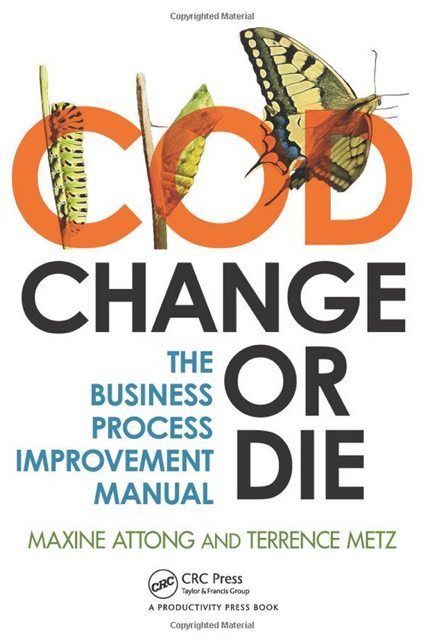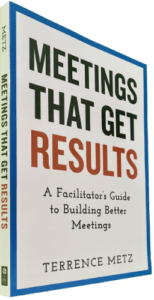If you or your group recognizes the opportunity to improve, you’ll benefit from Change or Die – The Business Process Improvement Manual (available on Amazon and other fine bookstores.) Co-written by Maxine Attong and Terrence Metz, it details a proven method, built upon proven examples of shared development and ownership.
Extracted from “Change or Die: The Business Process Improvement Manual,” published by CRC Press, the Taylor and Francis Group.
Change or Die captures the developments that occur during the planning phase of a Business Process Improvement project (BPI). The method described builds over time, upon multiple, facilitated workshops. For workshop agendas, tools, and details, refer to the book, pages 167 to 171, or other “Best Practices” articles at this MGRUSH site.
Business Process Improvement (BPI) Planning
Organizations make large investments in the development of their strategic plan. For example, the market rate for professional support services to help develop strategic plans may require four percent of the investment sums for consulting. Sometimes more. Over the years, we have also developed templates that we use over and over, to bring about consistent results. Hence, we use facilitated workshops to extract information and build consensus from senior management about their dreams and hopes for the organization.
The strategic plan reflects an understanding of why, what, and how. When the client wants to do it, how much it will cost, and the estimated return on monies invested. Overall, the strategic planning document provides a clear view of the organization’s intent and should be used to baseline performance.
The BPI strategic plan becomes clear during executive sanction. Following this, the BPI project can move ahead and transition from the process examination team to the implementation team. The process examination team’s plan provides clear communications to senior management about the team’s intention for the BPI. Specifically, they illustrate how it supports the organization’s strategic initiatives. Therefore, now is the time to sell the project to the executive team, receive their approval, and release the resources needed to complete a successful project.
Purpose of the Business Process Improvement Plan
BPI provides a reference point against which the process examination team will be evaluated. The BPI plan also provides a synopsis of what the BPI team(s) has been working on. Therefore, the document legitimizes the critical nature of the proposed BPI project.
Given the team’s first and foremost opportunity to sell the project, the team must:

BPI Phase One Check-Off
- Be prepared to defend the tables, statements, and figures presented.
- Document known assumptions.
- Ensure that others can audit their transparent methods and results.
- Establish the accuracy of the data.
- Include charts and tables.
- Plan carefully.
- Prepare an oral presentation with visual supplements for management.
- Sell the project—your organization’s future may just depend on it.
- Solicit support from the project sponsor.
Business Process Improvement Plan Elements
The BPI plan is the process examination team’s last action before the project transitions to the implementation team. As a result of the team’s findings and decisions, the BPI plan includes the following:
- Executive Summary
- The Problem
- The Solution
- Resources Needed
- The Process
- Vision, Goals, and Objectives
- SWOT Analysis
- Project Team
- Risks and Opportunities
- Resources
- Next Steps
- Conclusion
Executive Summary
Create a snapshot of the project that captures the imagination of the executives. Therefore, concisely state the results that will be created by its completion. Hence, include the project costs and expected return on the investment. Consequently, bear in mind that the executive summary may be all that an executive has time to read, so the summary serves as the deciding factor of whether the project gets approved or not.
The Problem
BPI responds to or anticipates a changing environment. The reader needs to identify with and believe that the problem is real and that the organization’s ability to meet its goals and objectives will be compromised if the problem goes unresolved.
State the pain that the process causes to the stakeholders and why it needs to be stopped. Process measurements and workflows provide evidence of what is wrong with the existing process.
The Solution
Develop a lofty purpose for the BPI. Therefore, state HOW and WHY the BPI project will resolve the problems identified.
Resources Needed
The project budget shows the investment needed by type of expense. Therefore, clearly state the return on the investment and the period for the returns. And for sure, including the assumptions that went into the number crunching.
The Process
Codify the reasons why you chose the specific process for improvement. Demonstrate that an auditable and transparent method was used for the selection of the process to be improved and include the results of the analysis.
Vision, Goals, and Objectives
Paint a picture of the future process; what it looks like, and how it assists the organization in achieving its strategic objectives. Therefore, include the vision, goals, and objectives of the BPI project and align them to your organization’s vision.
TO-WS Analysis
Strengthen the argument for the process vision, goals, and objectives by showing how strengths and opportunities relate to the vision. Consequently, determine how the weaknesses and the impact of threats might be reduced, converted, or removed by the project.
Project Implementation Team
Explain the implementation team and how and why the members were selected. Explain the selection criteria and present the implementation team charter.
Risks
The Risk Register highlights the risks with the highest probability of affecting the project. Explain the mitigation/ elimination strategies. Summarize the change management plan and the stakeholder analysis and include them with your strategies.
Opportunities
Highlight the opportunities that BPI presents. Therefore, identify any opportunities that have been taken advantage of thus far, such as the quick wins discussed earlier.
Resources
Include the updated project budget and highlight the critical costs. Hence, shows the basis of the project rate of return and the payback period.
Next Steps
Present an updated project plan and give an overall view of the next steps and the estimated dates. Highlight the key activities such as BPI plan acceptance by management, implementation team training, process design, project testing and implementation, and project completion.
Conclusion
Here provide a review and wrap-up of all the above. Do not introduce added information during the conclusion. All members of the process examination team and implementation teams need to sign off on the document (obtain signatures) showing commitment and buy-in of its contents.
Change or Die provides a life cycle approach on how to facilitate business process improvement within 250 pages of primary text. Hence, both print and electronic editions come with another 100 pages of workshop agendas, tools, and activities. The print edition contains a CD containing over 100 tables and templates in electronic form. Therefore, the nominal investment will pay for itself within the first hour or two of your perusal.
MGRUSH alumni will recognize some proven tools (eg, Guardian of Change) and some new activities to stimulate group performance. Consequently, the workshop agendas have been stress-tested with other clients and are proven to work.
Our publisher, Productivity Press, represents an imprint of the publishing house, CRC Press which operates as the science and technology book division of the Taylor & Francis Group. Established in 1783 in the United Kingdom, we are fortunate to be associated with one of the longest-established publishers in the history of printing. Taylor & Francis Group is now the academic publishing arm of Informa plc.
Maxine Attong (co-author, MGRUSH alumnae, and resident of the Republic of Trinidad and Tobago) may be found around the world signing copies at various conferences. You can’t miss her world-class smile (if you are lucky). Terrence Metz (co-author, MGRUSH alumni, lead instructor, and Managing Director) may be found elsewhere hosting MGRUSH workshops. Hence. either will gladly sign a copy for you and discuss questions you may have about deriving value from our team approach on how to facilitate business process improvement.
______
Don’t ruin your career by hosting bad meetings. Sign up for a workshop or send this to someone who should. MGRUSH workshops focus on meeting design and practice. Each person practices tools, methods, and activities every day during the week. Therefore, while some call this immersion, we call it the road to building high-value facilitation skills.
Our workshops also provide a superb way to earn up to 40 SEUs from the Scrum Alliance, 40 CDUs from IIBA, 40 Continuous Learning Points (CLPs) based on Federal Acquisition Certification Continuous Professional Learning Requirements using Training and Education activities, 40 Professional Development Units (PDUs) from SAVE International, as well as 4.0 CEUs for other professions. (See workshop and Reference Manual descriptions for details.)
Want a free 10-minute break timer? Sign up for our once-monthly newsletter HERE and receive a timer along with four other of our favorite facilitation tools, free.

Terrence Metz, president of MG RUSH Facilitation Training, was just 22-years-old and working as a Sales Engineer at Honeywell when he recognized a widespread problem—most meetings were ineffective and poorly led, wasting both time and company resources. However, he also observed meetings that worked. What set them apart? A well-prepared leader who structured the session to ensure participants contributed meaningfully and achieved clear outcomes.
Throughout his career, Metz, who earned an MBA from Kellogg (Northwestern University) experienced and also trained in various facilitation techniques. In 2004, he purchased MG RUSH where he shifted his focus toward improving established meeting designs and building a curriculum that would teach others how to lead, facilitate, and structure meetings that drive results. His expertise in training world-class facilitators led to the 2020 publication of Meetings That Get Results: A Guide to Building Better Meetings, a comprehensive resource on effectively building consensus.
Grounded in the principle that “nobody is smarter than everybody,” the book details the why, what, and how of building consensus when making decisions, planning, and solving problems. Along with a Participant’s Guide and supplemental workshops, it supports learning from foundational awareness to professional certification.
Metz’s first book, Change or Die: A Business Process Improvement Manual, tackled the challenges of process optimization. His upcoming book, Catalyst: Facilitating Innovation, focuses on meetings and workshops that don’t simply end when time runs out but conclude with actionable next steps and clear assignments—ensuring progress beyond discussions and ideas.





Aconex Oracle helps you objectively measure the work completed on a project at any given point and take necessary actions in case of a deviation.
Personally cannot speak to its efficacy George, but thanks for the suggestion to our readers.